#the crits are way more intense at my school though. you WILL learn what a hegemony is by the end of freshman yr
Text
I think wonky art deserves all the love in the world. I'd much rather see a funky collage/wobbly lineart combo that has a strong Vibe than like. A perfectly proportioned, regularly colored, stiff drawing of someone at a front angle that shows off someone's technical skill. Like, make your art weird and whacky!!!!! Lean into the stuff you like to do, even if it doesn't look 'good' yet!! Over time your skills will evolve & you'll get better no matter what, but the more you like to draw the easier it will be to get yourself to sit down & do it!!!!!!
#I'm at an art school and my sibling is taking fine art over at a normal college and his school cares So Much about making 'good' art#it seems really demoralizing to have to do like. shading practice and still lives for a semester b4 getting to move on#at my school we do some of that but usually if you have something else you wanna do the prof won't make a fuss#the crits are way more intense at my school though. you WILL learn what a hegemony is by the end of freshman yr#talking at you whether you like it or not
232 notes
·
View notes
Photo


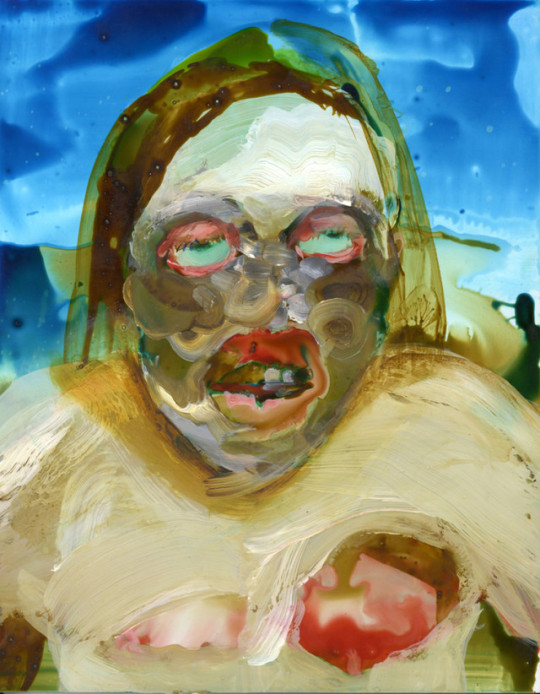
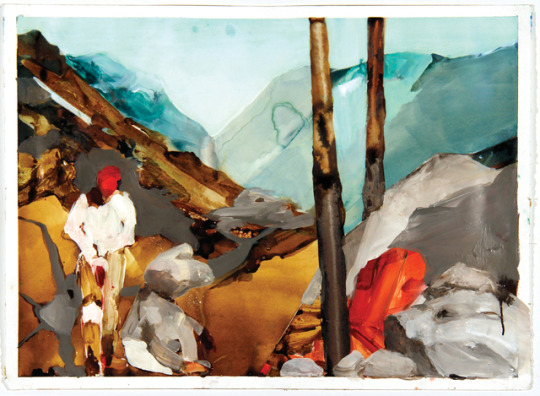
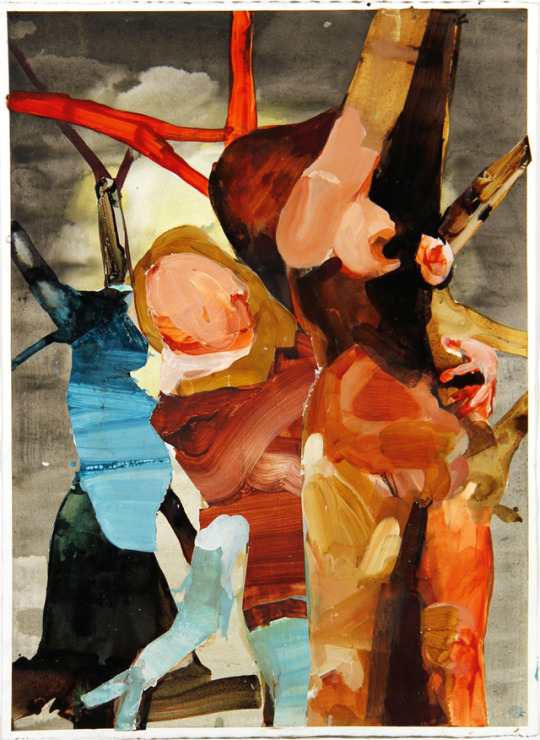
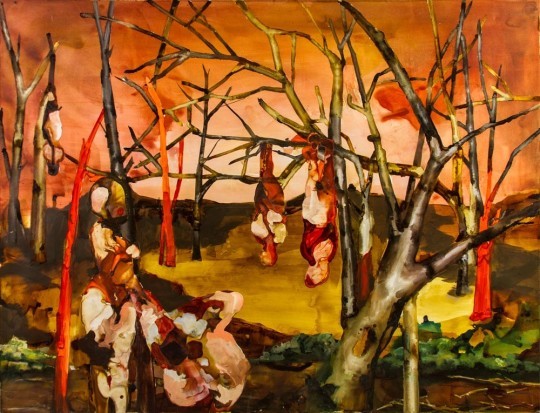
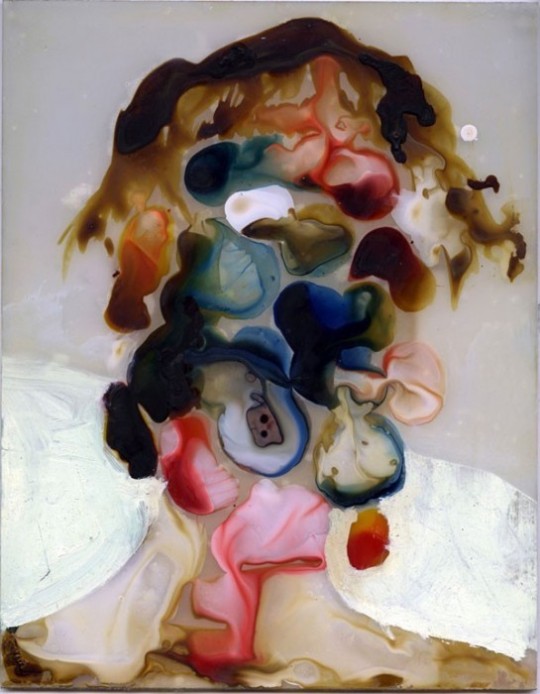
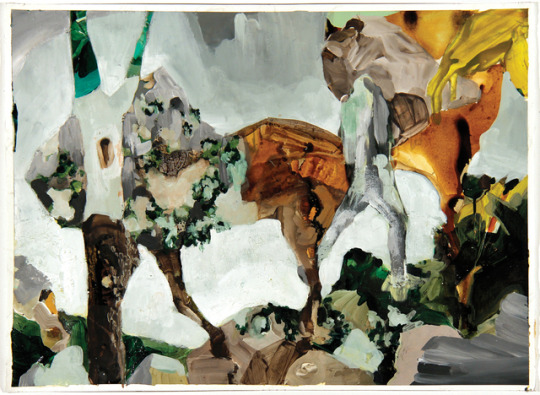
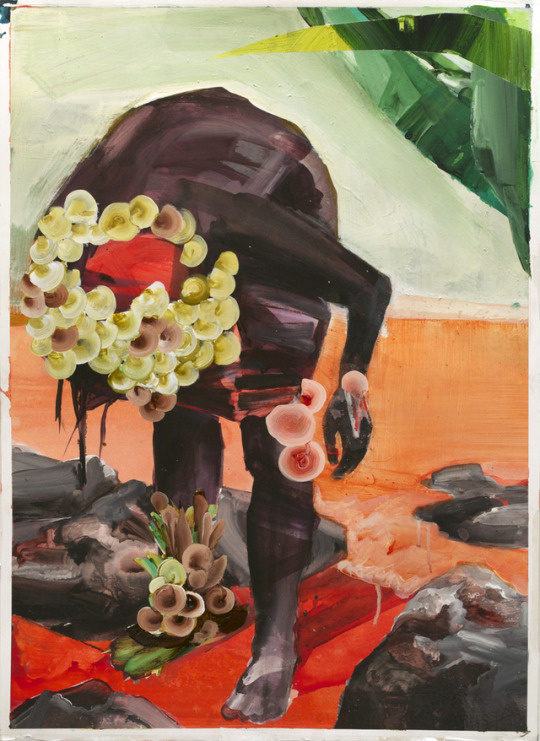
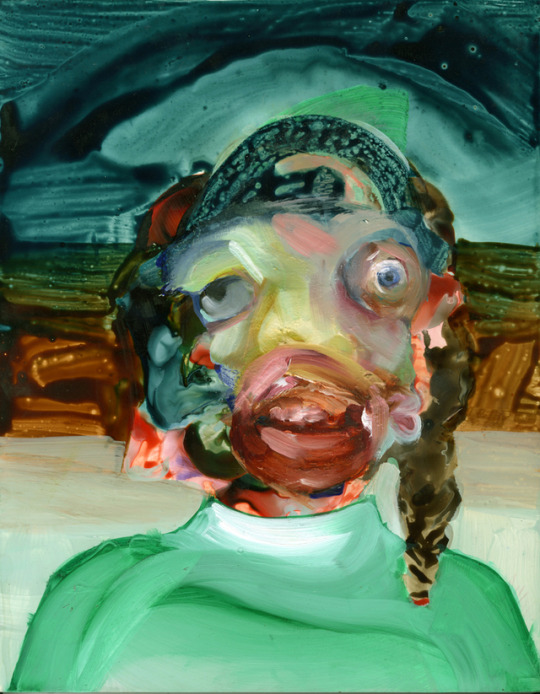
Interview: Elizabeth Glaessner, a painter living in Brooklyn, New York.
Before this visit, Elizabeth and I did not know each other but I had admired her paintings for years. I first encountered them in 2014 at PPOW, her NY gallery. Her work exists between abstraction and representation with dark human moments lurking within painted worlds.
It was important to me that the first studio visit in this series be with someone I didn’t already know but whose work interests me, partially because it functions in a realm outside of my own practice. I didn’t want to feel any personal familiarity with her work, or the comfort that comes with an inherent knowledge of that person or their process. This allowed me to be an open and inquisitive visitor.
I asked her a series of questions that address her studio practice and the associated struggles. We talked for about an hour about personal doubt, coping mechanisms, and book clubs.
The following conversations is excerpted from an interview on October 15, 2016 in Brooklyn, New York.
Where did you grow up?
I was born in Palo Alto, California and then moved with my family to New Orleans and then to Houston, Texas. I spent most of my time in Houston. Texas is another world; the landscape is wild. I’ve been in New York since 2007 so I do miss the wide open spaces. Driving across Texas is amazing, you can see and feel the landscape transform from a sticky swamp to a desert.
Houston also has a great art community. My mom is a painter, she taught at the Glassell School of Art, which is part of the MFAH (Museum of Fine Arts Houston). It offers classes like the Corcoran, but there’s no degree program. They also run a highly respected residency program called the Core program.
When I was in High school, I was on the Teen Council at the Contemporary Art Museum in Houston and one of the things we did was visit the Core artist studios. Trenton Doyle Hancock was a resident at the time, so we got to visit him there. That was a pivotal experience for me, everything in that space felt very alive and unreal in the best way and you could see that he was living his work. He was totally committed to what he was doing.
What is the driving force behind your work?
I feel like I couldn’t not do it. Growing up, it was the one thing I could always get lost in. I really enjoy the act of painting; I love that part as much as I love thinking about the ideas or the narrative.
When I am making, the small pieces especially, I reference things that I’m reading or experiencing now but then also combine that with things that have stuck with me from my past. So it feels like a natural way to reflect on the present and the past. I develop a lot of the stories in an intuitive way. With the pure act of painting the most exciting thing for me is trying something new and then being surprised with what happens. That allows for some of the content to be dictated by the process.
What is your biggest struggle in the studio?
Right now it is the size of my working space. If I had more space, I might be doing more of the larger paintings at the same time. I like to work on a lot of pieces simultaneously. Sometimes there is a positive thing in not being able to though, it forces me to put things away, which stops me from overworking them.
Put the following terms in order of importance to your studio practice:
Form, Concept, Process
I feel like they all inform each other. I have been thinking a lot about what I want the paintings to say but they aren’t extraordinarily specific. I am not totally interested in having an idea and then making a painting to show that idea. I start with vague ideas, I’ll think about a specific mood or particular landscape or color, then I start thinking about the narrative. I ask myself if it will be a dangerous painting or a lighter painting. They’re still open for people to experience them in their own way.
Was there ever a time when you felt like you couldn’t keep making work? If so, what helped you to keep going?
Yeah, there have been times when I question everything: the type of work I’m making, is the work important, etc. I’ve also had stretches where I fail a lot and I just keep making bad paintings. I make a ton of small pieces that no one sees. I was working on a huge piece earlier this summer, it’s a great example of a failure that took forever. It was haunting me. I would come in the studio and work on it every day and at a certain point I had to take it down, roll it up, and start new pieces.
This was my first large piece on canvas in a long time, and there was a lot of experimentation at the same time. I like to work fast and get it out and move on, but I got really stuck on this one. Sometimes I felt I had gone backwards that day, I would go home and obsess.
I take pictures in the studio and I would go home and look at the photos over and over again. I think a lot of it was figuring out how the materials I am used to working with on paper or panel worked on the canvas. I love working on paper, it is an amazing surface. Even though it takes a long time to prepare, it didn’t feel as daunting as painting on canvas.
I love the way wet media works on paper too, so when I was working on panel, that felt like the closest thing to the smooth surface of hot press paper. Canvas is more flexible, so when I wanted to bring some of the moments that occur in my other work into the large piece, it was a struggle. I learned that sometimes I’ll build up too much and then the piece dies. I just have to approach it differently. I put it away and work on something else, that’s how I deal with it.
Do you have any routines, rituals, or coping mechanisms that you use regularly in your studio practice?
If I am frustrated with a big piece, I will just sit on the floor and work on small pieces on paper. That feels like, comfortable, play time. I think that kind of stuff impacts my work a lot. Sitting on the floor I am immediately reminded of childhood, which can be very freeing. I also have a big table at my apartment, and sometimes do small pieces there, which is a totally different environment. It’s nice to go back and forth.
My studio mate and I usually listen to music and podcasts (though when I’m by myself it’s always music, I can’t really focus on anything else while I’m working). Every once in a while I’ll be listening to a weird station on Spotify and turn it off and realize that the music was putting me in a weird mood.
If I’m really focused, it all becomes white noise so I don’t immediately realize how it is affecting me. I like listening to This American Life outside of the studio, and recently I had it on while painting. This episode that was so fucked up, I had to turn it off and listen to it later. It was too intense.
Do you have any hobbies or interests outside of your studio practice that help keep you sane?
I run. I have been running forever, I used to run track in high school and my first year of college but it became too much with practices. I don’t do incredibly long distances but I need to do it or I become a terrible person to be around. Because I work a lot on the floor I have been noticing I’m getting back aches and pain, so I think it’s important to be physical. I’m also in a book club/crit group with some amazing artists and writers.
A friend of mine, Jessica Stoller, who went to Cranbrook started this womens crit group with a few of the other members while she was there and a lot of them ended up in New York. They’ve kept it up here and it keeps growing. We go to one person’s studio one day and then do the book club another day. We’ve read one of the Elena Ferrante books, a scandalous book called Tampa and just finished Americanah, which is probably my favorite book so far. The author, Chimamanda Ngozi Adichie, is an incredible writer.
We, as artists, are doing so many different things. We have our home life, our studio practice, day jobs, etc. and I think that if I don’t make borders or boundaries I will just feel completely overwhelmed. So my day job is completely separated from my studio practice. But home life/studio life is a gray area for me. I have not yet learned how to not let my art affect my mood outside of the studio.
Is there anything you would like to promote? Upcoming exhibitions, projects, passions?
I just had several small works on paper up in a group show at P.P.O.W. curated by Anneliis Beadnell. I’ll have a couple of pieces in some group shows coming up. One at SVA curated by Peter Hristoff and another in Chinatown. I’ll send out an email and post something on Instagram when it gets closer to the dates.
http://www.bmoreart.com/2016/10/inertia-elizabeth-glaessner.html
https://www.instagram.com/eglaessn/
4 notes
·
View notes
Text
Schooled by Old-School Combat

You might say it’s to die for…
I’m one of those people who fell in love with the Fire Emblem series through Fire Emblem Awakening…despite being comically horrible at strategy games at the time. Despite this, I managed to complete Fire Emblem Awakening and then enjoyed a somewhat intense training (lit. ego eviscerating) period with the Nohrian royal family. So when I was assigned to Fire Emblem Echoes: Shadows of Valentia as the product marketing lead—which is essentially the game expert who juggles communication between Japan, localization, and other teams while supporting global efforts to promote the game—I felt that my body was ready. While my ego may not have survived the experience, it’s definitely helped make me dig deep into the combat.
Fire Emblem Echoes: Shadows of Valentia is a reimagining of Fire Emblem Gaiden with gameplay and combat that remain true to those classic roots. It has the bones of Fire Emblem Gaiden at its core and all the dungeon crawling cream-center goodness that made its predecessor stand out from other games in the franchise.

Fire Emblem Gaiden released in 1992 on Famicom. The early 90’s-vibe is strong.
Fire Emblem Echoes: Shadows of Valentia offers a classic gameplay experience with the modern fan in mind. But since Gaiden was never released in the West, or in English, the ways in which this game stays true to its roots while creating its own identity might not be immediately obvious. So let’s dig into how this game compares to its inspiration and modern offerings in the franchise, specifically in terms of combat?
Fire Emblem Echoes: Shadows of Valentia is not like Fire Emblem Awakening or Fire Emblem Fates and really stands apart from all the other offerings in the franchise. Its combat system is back to the brutal basics, with no space pairing and no weapons triangle; rather, it favors a classic (i.e. merciless) battle style mixed with modern UI.

Old-school combat with a modern look and interface.
In this case, “back to the basics” doesn’t mean easy, and the game will not babysit you. Fire Emblem Echoes: Shadows of Valentia has its own system of strategic checks and balances, and you’ll need to learn how to use them to your advantage, because your enemies certainly will! I had to learn very quickly just how deep and challenging (cough…sadistic…cough) grid-based combat can get. We already covered a few of these mechanics in the Two Armies trailer, so from this point I’ll dive more into combat details we didn’t cover yet.
Fire Emblem Echoes: Shadows of Valentia has you controlling two separate armies in parallel.

Well, at least it’s not a selfie.
Each one has a unique makeup of classes and characters, and understanding the individual strengths and weaknesses often means the difference between victory and a grave mistake.
Classes work slightly differently from how they did in some of the more recent games, too. There are no “seals” in this game; instead, you head to one of the Mila Idols found in key places or within dungeons to change to the next class.

Here I thought a goddess couldn't get any more statuesque...yet here we are.
With the exception of Villagers, who can choose from four initial path options, characters can only progress along the line of promotion that’s permitted by their initial class.
This actually made the game that much more challenging for me, since there were only so many of each character class type. And a few characters definitely surprised me: a late-game recruit who I thought would be a glass cannon ended up being the best mage in both armies, and my favorite flamboyant Archer character ended up as a crit machine… You get the idea.


Concept art with class.
Character relationships are still in the game, but I was somewhat relieved to find that it has no marriage or children. While I’ve enjoyed getting the most bang for my buck with these mechanics, not having them actually upped the challenge and tension during battle for me. Even with two different armies, my forces weren’t unlimited! Not being able to breed replacements made me that much more careful with my battle tactics.
Speaking of character relationships, the support conversations are a crack up and give additional insight into the characters.

Plus some great one-liners too.
Support conversations only happen during battle, and as long as you position yourself within an attacking distance from an enemy (or healing distance from an ally), these conversations won’t eat a character’s turn. The near-full voicing of the game (about 90-95% of the game, from what I can tell) came as a pleasant surprise. The main story, support conversations, and even random NPCs in town are all fully voiced, and this made the story and cast of characters feel more relatable for me. The cinematics in the game (by Hideki Anno’s Studio khara) are also fully voiced and gorgeously animated.

So pretty…and fully voiced!

You can use your imagination for the obligatory joke about playing with sharp objects.
If you’re curious how this game handles abilities, that’s where Combat Arts come into play. In a nutshell, equipping certain items long-term allows characters to learn special abilities that they can use in battle (though the characters won’t be able to use these specific Arts while the items are unequipped). And unlike some of the other Fire Emblem games, your equipment in this game won’t break from extended use.
The Arts themselves vary from HP recovery effects (like getting damage you inflict back as HP), magic-resistance and magic-damage boosts, powerful attacks, and even the ability to prevent enemies from counterattacking. Equipment types tend to give similar Arts, but you may find a few that will surprise you. I spent some time testing who worked best with which Arts, but admittedly, it’s probably a task for smarter, more patient fans out there. However, I’d recommend using Arts strategically rather than just spamming them to see what they do - even if it IS fun in its own right, some of the Arts cost HP to use.
It wasn’t until well into my first playthrough that I remembered (more accurately, “rediscovered”) a mechanic called Mila’s Turnwheel.

Seen here on the lower screen, and which could be a metagame for those looking for a serious headache… I mean challenge.
Mistakes happen, and this game is particularly unforgiving of them, but the Turnwheel lets you roll back time to a previous turn so that you can try to correct your mistakes. It’s got a limited number of uses per battle, and these uses are restored once the map’s been cleared. It’s a pretty nifty mechanic. The Turnwheel can help you get a handle on the deeper tactics of a battle, while acting as a bit of a safety net for players who are not as steeped in turn-based strategy. I wish I had remembered Mila’s Turnwheel during my three-day headdesk campaign against the witch near Fear Mountain.

The swear jar got a lot of use.
So that’s a closer look at the combat mechanics in Fire Emblem Echoes: Shadows of Valentia. Think your tactics can stand up to the challenges of classic combat?
—Lindsey N.
211 notes
·
View notes
Text
Post Mortem: Runaway Magic

So the results for Ludum Dare 40 have been released! I figure this is a good time to review my project and what I learned from this whole experience. Runaway Magic scored 912th overall and broke the 300s for humor, and quite honestly I'm rather pleased with the results given the game.
Day 1
The theme for Ludum Dare 40 was "the more you have the worse it is". I spend the first few hours brainstorming before centering on the idea of "overloading on magic". Originally, I had prototyped a small arcade shooter that spawned enemies and you would have to cast magic to destroy them. Standard fair, with the caveat, that using too much magic could overload you. You had four types of magic, and you would have to change magic for certain enemy types. All very modular and easy to expand upon. Having gotten spawning down, the firing working, I moved on to trying to get the UI to work, because at the time you couldn't cast more than three of the same types of magic before you'd overload. Casting other magic would negate this.
The UI fought me at every turn. I spent several hours frustratingly trying to get the coloring to work (it would change the color of the dot to show what magic you'd used. I went to bed frustrated with the UI. While attempting to sleep, I thought up an interesting dialogue adventure, with scenarios to use magic.
Day 2
After messing with the UI for a few more hours, I decided to scrap that idea and try to build a dialogue system. I spent my entire Saturday beating my head against this. While a basic system could work, I could not get dialogue options to work properly, or display. I did very little else, as this was now the core of the game and needed to work before I could do anything else. I did, however, change the overload meter at this point to just a bar. You could cast different amount of magic, and it would fill up the overload meter in different amounts, without having to mess with colors or negating values.
I went to bed once again frustrated and questioning my change of idea, but I was already two days in and needed to stick to something. I searched the internet for some guidance, some help, and in the wee hours of the morning on Sunday, as the sun rose, I found Yarn.
Day 3
I woke up some hours later with a plan. I would spend two hours tops trying out Yarn and seeing if I could get it to work before I would scrap the entire dialogue system and go back to the arcade shooter. Low and behold, an hour later of looking at the documentation and seeing how it was implemented (as my roommates went to the gym without me) I had working dialogue, with functional variables and options. I rejoiced, I cheered, I then spend two hours making a base character model in Maya.
Then began my long vigil.
With 24 hours to go, I had no content, a very basic, poorly animated green witch who was stuck in the T-pose, and a fierce determination to finish something. I implemented the enemy spawning from before, and built a simple starting zone for the prologue and first set of dialogue. I used a wonderful set of assets from KenneyAssets, which greatly sped up my process. My best friend suggested I use mushrooms for the enemies, to which I added eyes to hilarious effect. He went to bed and I plowed into dialogue creation, level design, and sacrifice of sleep.
Day 4
My other roommate came down at about 10 am to ask "have you been up all night" to which I answered yes. By this point, the dialogue had reached the 4th wall, broke it, and taken a trip to what I can only assume happens when you're on mushrooms. (I took the 'shroom theme way too far.) I had two scenarios to design in the editor, having spent the last hour recovering from Unity crashing on me. I finished up this portion, finally, with roughly five hours to go. I played through to make sure the dialogue trees worked, that the nav mesh I was using wasn't breaking, that the spawner worked (it hadn't for a while during the night) and moved on to making menus.
My menus took very little time, and I spend most of the remaining four hours bug fixing. Not that I found all of them until AFTER I'd submitted, mind you. I made a few quality of life improvements, messed with post-processing, and finally forced myself to stop messing with it with half an hour before the deadline.
Submission/Post-Submission
I tried to build for WebGL first. It wouldn't build. So I built for Windows. Then restarted Unity and successfully built for WebGL and submitted that to itch.io. Except, when I tested it, the dialogue didn't work. I, to this day, have no idea why the dialogue UI breaks. I have no idea why YarnSpinner will not work with WebGL. It just doesn't.
I am told, some hours after playing the game for my guy roommate - who almost hurts himself laughing so hard at my dialogue - that the Windows build doesn't actually work, because low and behold, I forgot the data folder! I fix a rather big bug at the end where not only does the boss try charging you after you get the castle open, but the mushrooms /that have been constantly spawning behind you/ rush you at the game win UI screen, and re-upload my build. With that, I finish fixing bugs and leave it for review.
(After the fact I realized I'd broken the character model - which was why it wouldn't animate - by deleting all the bones because, silly me, I thought it wasn't necessary.)
What Worked:
Yarn! Using the Kenney Assets. I am incredibly good at taking a pack of assets and spending /hours/ doing nothing but creating a world. Yarn is a pleasure to use, though sometimes it bugs out a little (which given it's in Alpha is expected) and the Yarn Spinner plugin is a godsend for creating dialogue systems that work properly with little finagling. I went into the jam with a really good goal of finishing something, and I did! The humor was rather good, though you could tell I was sleep deprived, and I did not proofread anything before I submitted, as I did the dialogue development in Yarn itself, and not a word processing program first.
What Didn't Work:
Runaway Magic has very little in the way of gameplay outside of the dialogue. It's a common crit people gave of it, and I agree with it wholeheartedly. I scraped some decent combat to try to beat my head against dialogue - I spent too long trying to get it to work instead of just moving on or finding a solution - when I could have easily melded the two together to make something more interesting and intense.
What I Learned:
Do not attempt to hand code a dialogue system in a 72 hour period. Simplicity is better than overcomplicating. Sleep, always sleep.
On a more self-development level, I learned a lot about myself and my work ethic. I will beat my head against a problem until it's solved, even if it's not a good idea to do so. I need to be aware of this and set limits for myself for how long I'll try to get something to work before moving on. I am actually halfway decent at this game development thing! I may not have scored super well, but I produced a game for the first time since I graduated school, and I ain't half bad. I'd been in a slump for so long, simply working on Mayu's Lantern to work on it and not really produce anything, and feeling rather, well, worthless as a person. So being able to actually produce a finished - if flawed and ultimately not particularly good - product and release it to the world.
For Next Time:
For the next Ludum Dare, I'm planning on being more aware of my process and working smarter. If I run into an issue I can't solve in an hour or so, that's not the solution I'm looking for (aside from compile errors 'course ). More use of the theme too. The final version of Runaway Magic didn't really use the theme, whereas the first version had some good stuff going for it.
Anyway! That's it for now! I will have a new update on my plans for 2018 in a few days; I have a few ideas rolling around and a challenge for myself for the year.
Until next time!
0 notes
Text
Why I don’t hate the MICU
1. Social problems aren’t my problem. Honestly, this is probably the worst part of internal medicine in general. You get so many people who have no insurance, no money, and no way to get the care they need. Trying to connect the dots between what’s necessary and what’s realistic really crushes your soul after a while. Especially when I never went to med school with the idea of being a social worker and the social worker who did actually sign up to be a social worker is either grossly overworked or borderline incompetent and lazy. In the MICU that’s not my problem. My problem is to attempt to keep the patient from dying, whatever the costs. Placement will be the floor’s problem.
2. Cool, complex cases. You see some crazy shit in the MICU. These people are typically the sickest of the sick, many floating a very thin line between life and death. In less than a week, I’ve already seen and treated some stuff that, up until now, I’ve only read about in books. While this sometimes can be overwhelming, at the end of the day it’s still really cool to see new pathology.
3. The attendings love teaching and love their jobs. My experience so far has been that Pulm/Crit docs really enjoy their job. More importantly, they’re excited about their job and share that excitement in the form of teaching. A lot. For me, that’s clutch. I can make myself read about nearly anything so long as I’m constantly being challenged (in a good way) and being taught by someone who has a genuine love of the subject matter.
4. Scrubs. Fuck yes, glorified pajamas all day every day. What can be better?
5. Procedures. I hate procedures, but it sure as fuck is easier to learn a procedure on someone who is unconscious than an awake patient.
There are absolutely bad parts to being in the MICU. The hours are long and intense. It can be crazy overwhelming, especially when you get stuck with super sick, super complicated patients or multiple patients crash simultaneously. You’re drowning in death and dying almost every day. Though I have to give our MICU props because, unlike many of the other services I’ve rotated through this year, they do an excellent job of recognizing the limitations of what medicine can do and appropriately identifying patients are appropriate for palliative care.
46 notes
·
View notes